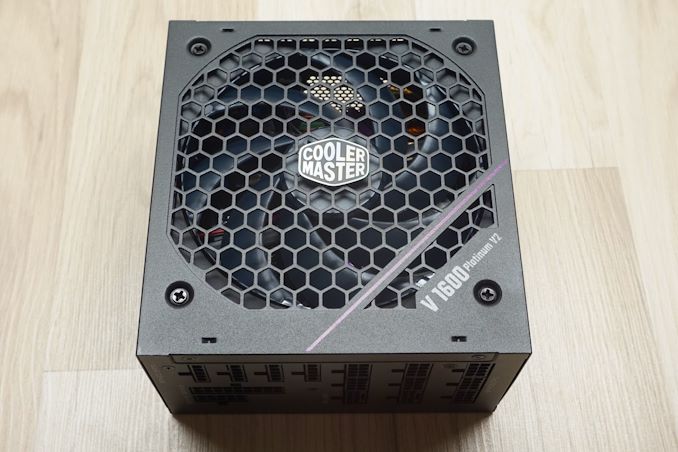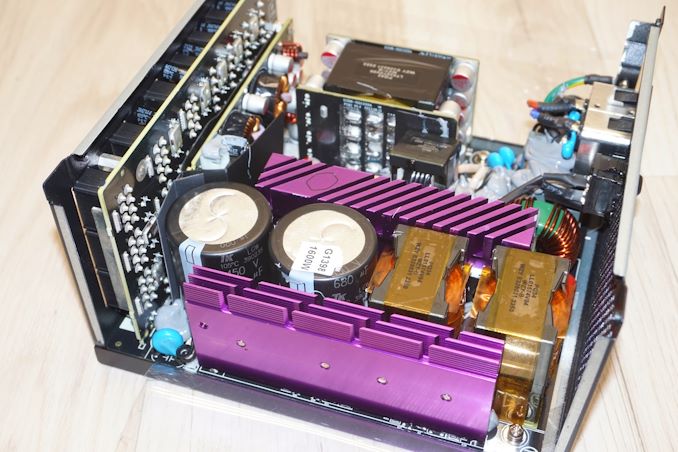The Cooler Master V Platinum V2 1600W ATX 3.1 PSU Review: Quiet Giant
by E. Fylladitakis on July 31, 2024 10:00 AM ESTPower Supply Quality
| Main Output | ||||||||
| Load (Watts) | 324.01 W | 806.64 W | 1207.08 W | 1601.38 W | ||||
| Load (Percent) | 20.25% | 50.41% | 75.44% | 100.09% | ||||
| Amperes | Volts | Amperes | Volts | Amperes | Volts | Amperes | Volts | |
| 3.3 V | 1.9 | 3.43 | 4.75 | 3.41 | 7.13 | 3.41 | 9.51 | 3.39 |
| 5 V | 1.9 | 5.13 | 4.75 | 5.09 | 7.13 | 5.08 | 9.51 | 5.05 |
| 12 V | 25.35 | 12.14 | 63.38 | 12.09 | 95.07 | 12.06 | 126.76 | 12 |
| Line | Regulation (20% to 100% load) |
Voltage Ripple (mV) | |||||
| 20% Load | 50% Load | 75% Load | 100% Load | CL1 12V |
CL2 3.3V + 5V |
||
| 3.3V | 1.4% | 14 | 18 | 22 | 32 | 18 | 22 |
| 5V | 1.6% | 16 | 18 | 26 | 36 | 22 | 28 |
| 12V | 1.1% | 24 | 22 | 36 | 62 | 34 | 32 |
The electrical performance of the Cooler Master V Platinum 1600 V2 PSU is adequate for its class, but there is room for improvement. The 12V rail maintains a fairly good regulation of 1.1%, while the 5V and 3.3V lines are adequately regulated at 1.6% and 1.4% respectively. Ripple suppression is fair, with maximum values of 62 mV for the 12V line, 36 mV for the 5V line, and 32 mV for the 3.3V line. We should note that voltage ripple is much lower at lower loads but spike when the load is at 100% of the unit’s capacity, suggesting thermal stress. These figures do not set any new records but are well within the recommended design limits and are adequate for a quality PSU.
During our thorough assessment, we evaluate the essential protection features of every power supply unit we review, including Over Current Protection (OCP), Over Voltage Protection (OVP), Over Power Protection (OPP), and Short Circuit Protection (SCP). The Cooler Master V Platinum 1600 V2 PSU successfully passed all critical protection tests, confirming its effectiveness in safeguarding both the PSU and connected components. The unit displayed standard OCP settings for the 3.3V and 5V rails, activating at 116% for both, which are typical for these specifications. The 12V rail’s OCP activation at 127% is slightly higher, aligning with current industry practices where manufacturers adjust protections to meet power excursion guidelines.
Conclusion
The Cooler Master V Platinum 1600 V2 PSU, retailing at $310, enters the high-wattage market with a notable balance of pros and cons. This price point is high but justifiable considering its substantial power output, which aims it at enthusiasts and professionals requiring reliable and robust power delivery for high-powered systems. And while it offers an array of features and fairly good overall performance, a thorough examination reveals some quality and performance hiccups.
On the electrical front, the V Platinum 1600 V2 delivers adequate performance. Its efficiency just meets the 80Plus Platinum certification, with cold test efficiencies of 90.8% at 115 VAC and 92.1% at 230 VAC. During hot testing, these figures drop slightly to 89.2% and 90.5%, respectively. While these numbers are respectable, they are unimpressive. Voltage regulation is good, with the 12V rail at 1.1%, the 5V rail at 1.6%, and the 3.3V rail at 1.4%. Ripple suppression, with values of 62 mV for the 12V line, 36 mV for the 5V line, and 32 mV for the 3.3V line, is satisfactory but not exceptional. Overall, the power quality is respectable but it falls short of being impressive.
Meanwhile the thermal performance of the V Platinum 1600 V2 stands out as a significant strength. The unit maintains excellent internal temperatures even under heavy loads, thanks to its efficient overall cooling design. The Mobius fan is thermally controlled, operating only when needed. In typical room temperatures, the fan may not operate at all unless the load is greater than 800 Watts, but will reach its full speed if the unit is fully loaded inside an adverse environment. This thermal management strategy effectively prevents thermal stress and maintains long-term reliability even at high power outputs.
Acoustic performance is another highlight of the V Platinum 1600 V2. The 135mm fan and its hybrid operational mode keeps the unit silent at loads up to 800 Watts, which should be sufficient for most gaming PCs with just one video card installed. As the load increases, the fan speed ramps up, but it manages to balance cooling needs without becoming overly noisy until it reaches loads above 1200 Watts – and that if the ambient temperature is high. This feature makes the PSU suitable for users who prioritize quiet operation during regular use but are willing to accept higher noise levels under extreme conditions.
In conclusion, the Cooler Master V Platinum 1600 V2 PSU offers a combination of adequate electrical performance and outstanding thermal and acoustic characteristics. For those concerned about its build quality, Cooler Master backs this unit up with a 12-year manufacturer’s warranty to alleviate any concerns. At a retail price of $310, it presents a fair value proposition for those needing a very powerful for a system with two powerful video cards or AI accelerators, or for limiting the noise output of a system with one high-powered card installed.












6 Comments
View All Comments
Threska - Wednesday, July 31, 2024 - link
At this rate we'll have to wire in our PCs like mainframes of old complete with water cooling.ballsystemlord - Wednesday, July 31, 2024 - link
Cooler Master should also sample this PSU to the YT'er Gamers Nexus. Steve has an opinion about glue. ;)PeachNCream - Thursday, August 8, 2024 - link
Isn't Steve the really hairy dude that used to work at HardOCP before it closed down?Oxford Guy - Thursday, August 1, 2024 - link
It’s worthwhile to spend extra on an oversized PSU if using a higher-end GPU to reduce noise.What would be nicer would be larger-than-ATX designs that use 200mm fans at very low RPMs. Cramming so many watts into small cases is an antique approach.
Khanan - Sunday, August 4, 2024 - link
Doesn’t make much sense as there’s no norm for such designs, it would first need a different standard than ATX, but your idea doesn’t make much sense in general, bigger isn’t better and the current designs work very well.Oxford Guy - Thursday, August 22, 2024 - link
Of course it makes sense. What doesn't make sense is stuffing 1300 watts into an ITX case and yet people are trying that.ATX is an ancient outdated standard. GPUs have long been the best illustration of that but even PSUs are problematic now that more people have realized that noise pollution isn't wonderful.